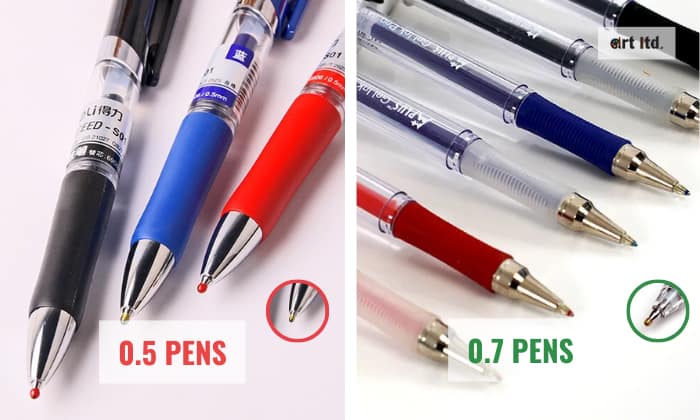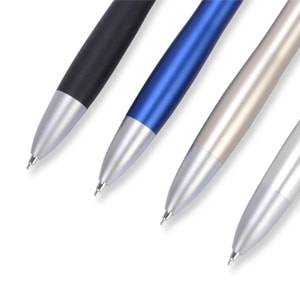When it comes to pen tip size for writing, you may have heard about 0.5mm and 0.7mm which are the most common sizes in the pen point sizes chart.
While 0.5mm pens offer detail-oriented tasks and intricate handwriting, 0.7mm ones stand out for their distinct, eye-catching strokes. Each brings unique attributes to the table.
This article will dive into the 0.5 vs 0.7 pen sizes mm comparison, highlighting their differences and exploring which tasks each pen size is best suited for. Let’s keep reading!
Table of Contents
What Are 0.5 vs. 0.7 Pens?
First of all, 0.5 vs. 0.7 terms refer to the types of pen points. Both of them are the most popular in the pen tip size chart.
A 0.5mm pen has a finer tip, producing thinner lines. This size is most suitable for those with smaller writing, which requires precision and neatness in their work, such as detailed drawings, small handwriting, or intricate notations.
Conversely, a 0.7mm pen has a broader tip, creating thicker lines. Its thicker stroke makes it a popular choice for people with larger handwriting. So if your work requires bolder and more visible lines, you better go with 0.7.
If you wonder which is thinner in size, a 0.5 pen is obviously thinner than a 0.7 pen.
What Are the Differences?
When looking at the pen thickness chart, the main differences between 0.7 and 0.5 pens lie in their tip sizes and the resulting line thickness.
- Line Thickness: 0.7mm pens produce thicker lines, while 0.5mm pens generate detailed lines.
- Visibility: The lines produced by 0.7mm pens are generally more visible. They are ideal for headings, underlining, and highlighting. 0.5mm nibs are less bold and suited for regular writing and fine detailing.
- Precision: 0.5 offers greater precision. Most people use them for detailed drawings or small, neat handwriting. In contrast, the broader stroke of 0.7mm pens can be less precise.
- Ink Consumption: 0.7mm pens usually consume more ink than 0.5 because of their thicker lines.
- Writing Pressure: .7mm points often handle high writing pressure better, whereas .5 might require a lighter hand to prevent damage to the tip.
Which is Better?
Choosing between a 0.5mm and 0.7mm pen depends on your writing style and specific requirements for line thickness and boldness.
A 0.5mm pen offers fine lines and less ink bleeding. This may be ideal for those working with detailed work. However, it may require more pressure to write with.
A 0.7mm pen, on the other hand, produces thicker, bolder lines. It’s great for larger handwriting and highlighting key points but may bleed through thin paper.
Here are the advantages and drawbacks of using the 0.7 mm vs 0.5 mm pen:
1. 0.5mm Pens
- Precision Writing: A 0.5mm nib excels when it comes to tasks that require meticulousness, like fine-line drawing or writing in a small space.
- Longer Ink Life: Given their thinner lines, these pens tend to have a longer ink life as they use less ink per stroke.
- Ideal for Small Handwriting: If your script is small and neat, a 0.5mm pen can accentuate your writing beautifully.
- Delicate Tip: The finer tip can be prone to damage if subjected to heavy pressure.
- Less Visible: The thin lines may not stand out as much, particularly for tasks like highlighting or headline writing.
- Can Feel Scratchy: If used on certain types of paper, the fine point can feel scratchy and less smooth compared to its 0.7mm counterpart.
2. 0.7mm Pens
- Strong Impact: 0.7mm pens produce striking, robust writing that’s hard to miss.
- Enhanced Durability: With a broader tip, these pens can withstand firmer pressure, reducing the risk of the tip becoming deformed.
- Ideal for Larger Script: If your penmanship tends to be on the larger side, a 0.7mm pen accommodates this style gracefully.
- Increased Ink Usage: These pens have a tendency to exhaust ink supplies quicker due to their broader strokes.
- Less Precision: The thick lines may not be suitable for intricate detailing or minuscule handwriting.
- Possible Smudging: With a greater volume of ink on paper, there’s an elevated risk of smudging, especially for left-handed writers.
How to Know Whether to Use?
When deciding whether to use a 0.5mm or 0.7mm pen, personal preference plays a key role. For individuals with smaller handwriting or those who are left-handed, a 0.5mm pen is a good choice. These fine point pens size allow for thin lines that minimize smearing or jumbling.
In contrast, if you prefer thick, bold lines, 0.7 may be more suitable. It offers a larger stroke size while maintaining legibility. Additionally, the ink flows faster and smoother, potentially making the writing process easier and less tiring.
Read more: How Does a Ball Point Pen Work?
Frequently Asked Questions
Example for each pen tip
- 0.5mm pen tip
When it comes to the 0.5mm pen tip, the Pentel EnerGel RTX pen serves as an excellent practical example. This pen has garnered high ratings on Amazon for its exceptional performance.
It boasts smooth writing and quick-drying ink, setting it apart as one of the best rollerball pens available. The Pentel EnerGel RTX pen offers an array of vibrant colors.
Customers have praised its ability to prevent smearing and its smooth, uninterrupted writing experience.
- 0.7mm pen tip
TUL 0.7mm retractable gel pen is the most popular 0.7 mm pen, featuring a comfortable grip and a sleek outer casing available in various appealing colors.
Although detailed reviews are limited, the overwhelmingly positive feedback suggests that the TUL 0.7mm pens excel in producing neat and precise writing, reflected by the majority of five-star ratings.
Which Is Smaller 0.7 Or 0.5 Pen?
A 0.5mm pen yielfds thinner lines, denoting a smaller size than a 0.7mm pen. This translates into enhanced accuracy, ideal for intricate tasks or minuscule handwriting, whereas a 0.7mm pen renders broader, more visible strokes.
Pentel Energel 0.5 Vs 0.7, Which Is More Popular?
When considering different pen tips, individual preferences and requirements greatly influence popularity. However, based on general observations, the Pentel EnerGel 0.7mm pen tends to be slightly more popular. The 0.7mm size offers a balance between smooth writing and bold lines.
Ultimately, these two gel pen tip sizes are some of the most common type of pen tips in the market. It’s recommended to try both sizes to determine which one best suits you.
What Is The Thickest Ballpoint Pen?
The thickest ballpoint pens typically have a tip size of 1.6mm. These pens are designed to produce bold and noticeable lines. It’s worth noting that there may be variations in the thickness among different brands and models.
Conclusion
This article 0.5 vs 0.7 pen article highlights their distinct characteristics and applications. The 0.5mm tip is praised for its precision and suitability for intricate tasks. It ensures clean lines and reduced ink bleeding.
The 0.7mm tip appeals to those seeking bolder lines and a more substantial writing experience. It finds favor among individuals with larger handwriting or those desiring a more pronounced stroke.
Understanding the differences between these two pen tips allows writers to make informed choices based on their specific needs and preferences.

Art has always been a part of my life; it influences my upbringing and later my career choice. For me, it is always a part of my parenting technique. So for whichever purpose that you come to art, you can start here with us.







